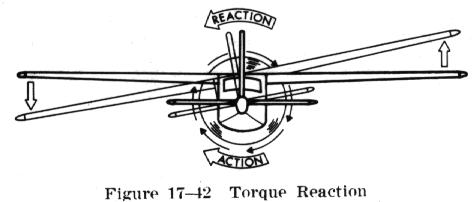
Torque reaction involves Newton's Third Law of Physics - for every action, there is an equal and opposite reaction. As applied to the airplane, this means that as the internal engine parts and propeller are revolving in one direction, an equal force is trying to rotate the airplane in the opposite direction (Fig. 17-42).

When the airplane is airborne, this force is acting around the longitudinal axis, tending to make the airplane roll. To compensate for this, some of the older airplanes are rigged in a manner to create more lift on the wing which is being forced downward. The more modern airplanes are designed with the engine offset to counteract this effect of torque.
NOTE - Most United States built aircraft engines rotate the propeller clockwise, as viewed from the pilot's seat. The discussion here is with reference to those engines.
Generally, the compensating factors are permanently set
so that they compensate for this force at cruising speed, since most of
the airplane's operating lift is at that speed. However, aileron trim tabs
permit further adjustment for other speeds.
When the airplane's wheels are on the ground during the
takeoff roll, an additional turning moment around the vertical axis is
induced by torque reaction. As the left side of the airplane is being forced
down by torque reaction, more weight is being placed on the left main landing
gear. This results in more ground friction, or drag, on the left tire than
on the right, causing a further turning moment to the left. The magnitude
of this moment is dependent on many variables. Some of these variables
are: (1) size and horsepower of engine, (2) size of propeller and the RPM,
(3) size of the airplane, and (4) condition of the ground surface.
This yawing moment on the takeoff roll is corrected by
the pilot's proper use of the rudder or rudder trim.